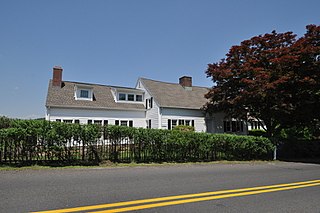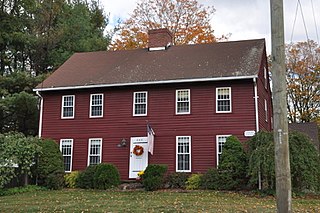
The Barnes-Frost House is a historic house at 1177 Marion Avenue in the Marion section of Southington, Connecticut. Built about 1795, it is a high quality local example of late Colonial architecture, with a history of ownership by members of prominent local families. It was listed on the National Register of Historic Places in 1989.

The Luman Andrews House is a historic house at 469 Andrews Street in Southington, Connecticut. Built in 1745, it is one of the oldest houses in Southington. Its property was also the site of the early manufacture of hydraulic cement. The 1.8-acre (0.73 ha) property was listed on the National Register of Historic Places in 1989.

The Josiah Cowles House is a historic house at 184 Marion Avenue, in the Plantsville section of Southington, Connecticut. Built in the mid-18th century, it is a well-preserved local example of Georgian architecture. It was listed on the National Register of Historic Places in 1989. It presently houses a bed and breakfast inn.

The Jonathan Warner House, also known as Warner-Brooks House, is a historic house at 47 King's Highway in Chester, Connecticut. Built in 1798, it is a well-preserved local example of Federal period architecture, featured prominently by architectural historian J. Frederick Kelly in The Early Domestic Architecture of Connecticut (1963). The house was listed on the National Register of Historic Places in 1978.

Rev. John Wightman House is a historic American colonial house at 1024 Mount Vernon Road in Southington, Connecticut. It was built about 1770 for the town's second Baptist minister, and is a good local example of Georgian architecture. It was added to the National Register of Historic Places in 1989.

The Icabod Bradley House is a historic building at 537 Shuttle Meadow Road in Southington, Connecticut. Built in 1813, it is a good local example of transitional Colonial-Federal architecture. It was listed on the National Register of Historic Places in 1989.

The Avery Clark House is a historic house at 1460 Meriden Avenue in Southington, Connecticut. Built about 1792, it is one of the town's surviving 18th-century houses, and well-preserved example of late Georgian vernacular architecture. It was listed on the National Register of Historic Places in 1989.

The Ebenezer Evans House is a historic house at 17 Long Bottom Road in Southington, Connecticut. Built about 1767, it is a well-preserved example of a Georgian Cape house. It was listed on the National Register of Historic Places in 1989.

The Stephen Grannis House was a historic house at 1193 West Street in Southington, Connecticut. Built about 1812, it was a good local example of Federal period architecture. It was listed on the National Register of Historic Places in 1989, and was demolished sometime thereafter.

The Timothy Hart House is a historic house at 521 Flanders Road in Southington, Connecticut. Built about 1810, it is a well-preserved local example of vernacular early 19th-century Federal period architecture. It was listed on the National Register of Historic Places in 1989.

590 West Street is a historic house in Southington, Connecticut. Built about 1790, it is one of the town's small number of surviving 18th-century houses, and a well-preserved example of Georgian colonial architecture. It was listed on the National Register in 1989.

The Roswell Moore II House is a historic house at 1166 Andrews Street in Southington, Connecticut. Built around 1787, it is one of a small number of surviving 18th-century houses in the town, and is a well-preserved example of Georgian architecture. It was listed on the National Register of Historic Places in 2005.

The Dr. J. Porter House is a historic house at 391 Belleview Avenue in Southington, Connecticut. Estimated to have been built about 1728, it is one of the town's few surviving 18th-century houses. It was home from 1754 home to one of the town's largest landowners. It was listed on the National Register of Historic Places in 1989.

Dr. Henry Skelton House is a historic house at 889 South Main Street in Southington, Connecticut. Built about 1748, it is a well-preserved example of colonial Georgian architecture. It was listed on the National Register of Historic Places in 1989.

The Valentine Wightman House was a historic house at 1112 Mount Vernon Road in Southington, Connecticut. It was built around 1800 and was added to the National Register of Historic Places in 1989. It has apparently been demolished.

The Woodruff House is a historic house at 377 Berlin Street in Southington, Connecticut. Built about 1780, it is a well-preserved example of an 18th-century Cape with later Greek Revival styling. It was listed on the National Register of Historic Places in 1989.

The Ezekiel Woodruff House is a historic house at 1152 East Street in Southington, Connecticut., Built in the mid-to-late 18th-century, it is a well-preserved example of a Georgian Cape style house. It was listed on the National Register of Historic Places in 1989.

The Jotham Woodruff House is a historic house at 11 Alyssa Court in Southington, Connecticut. Probably built about 1790, it is a good local example of late Georgian architecture with later Greek Revival alterations. It was listed on the National Register of Historic Places in 1989.

The Urbana Woodruff House is a historic house at 1096 East Street in Southington, Connecticut. Built about 1784, it is a well-preserved example of vernacular Georgian architecture. It was listed on the National Register of Historic Places in 1989.

The Jabez Bacon House is a historic house on Hollow Road in Woodbury, Connecticut. Built in 1760 for a prominent regional merchant, it is a well-preserved example of Georgian architecture. It was listed on the National Register of Historic Places in 1971.






















